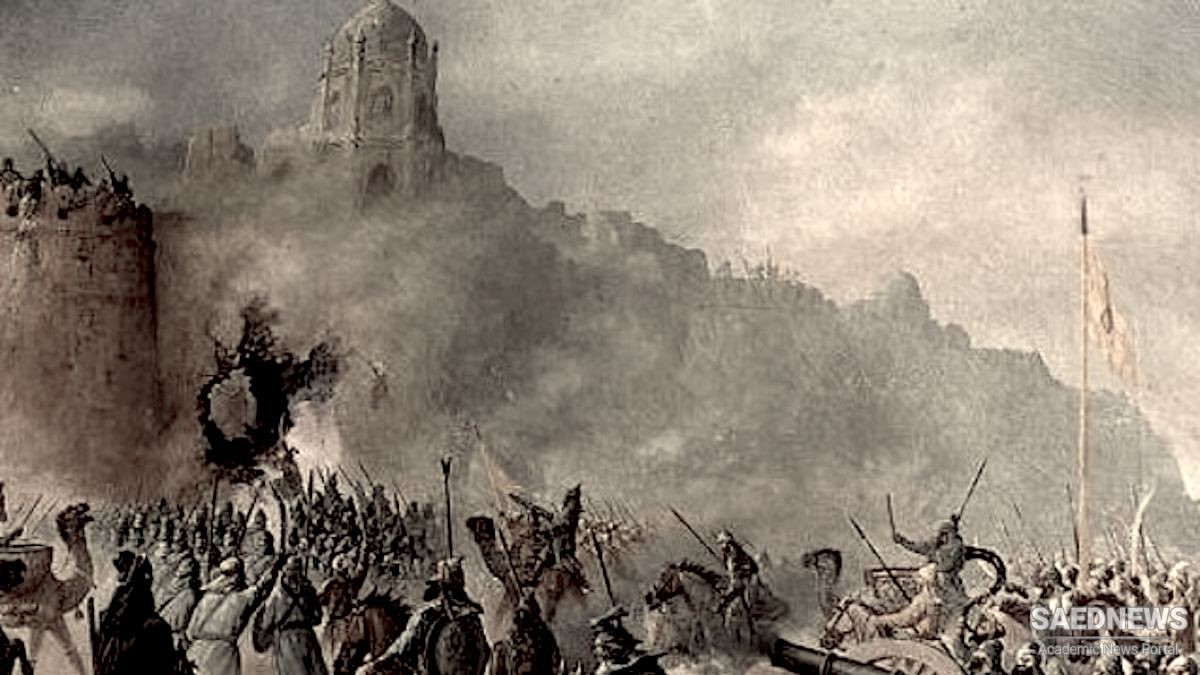The main Ghaznavid effort was directed across the Punjab towards the Ganges-Jumna Doab. Here lay Indian towns richly endowed with temples, such as the temple of Chakraswami at Thanesar (raided in 405/1014) and the temple at Mathura, reputed birthplace of the hero Krishna (raided in 409/1018). With these preparatory successes, Mahmud was ready to confront the two chief rulers of northern India, the Pratihara Raja of Kanauj, Rajyapal, and the Chandel Raja of Kalinjar, Ganda. Ganda was the most tenacious of Mahmud's opponents. In 410/1019 he organized a league of Indian princes against Mahmud, but during the expedition of 413/1022 Ganda was besieged in his fortress of Kalinjar and eventually forced to surrender.
Yet the climax of the sultan's Indian campaigns was undoubtedly the Somnath expedition of 416-17/1025-6. For this, Mahmud led his troops across the inhospitable Thar Desert to Anhalwara, and then into the Kathiawar peninsula to Somnath itself. At Somnath was a famous temple containing a linga of the Moon-God Mahadeva, which was served by 1,000 Brahmans and 350 singers and dancers, and endowed with the income from 10,000 villages. After fierce fighting, the shrine was captured and despoiled to the amount of twenty million dinars, and finally burnt down. The return journey was arduous and dangerous, and whilst travelling up the Indus valley, the Ghaznavid army was harassed by the local Jats; Mahmud returned in 418/1026 to lead a punitive expedition against these marauders. The news of the Somnath victory spread rapidly throughout the Islamic world, and contributed much to the image of Mahmud as the hero of Sunni Islam; the Abbasid Caliph sent from Baghdad fresh honorific titles for the sultan and his family.
Ghaznavid military activity in India was, as is clear from the preceding paragraph, essentially composed of plunder raids. From the temple treasures came the bullion which enabled the sultans to maintain a good standard of gold and silver coinage, and the extra currency in circulation stimulated trade all over eastern Islam, reversing for a while the normal drain of specie into the Indian subcontinent. This treasure was also used to finance and to adorn the splendid buildings which Mahmud began to erect, such as the "'Arils al-falak "Bride of Heaven" mosque and madrasa in Ghazna (built from the proceeds of the expedition of 410/1019 against Trilochanpal of Kanauj and Ganda of Kalinjar), and the vast complex of palace buildings laid out in early Ghaznavid times on the lower Helmand river at Lashkari Bazar near Bust. The slaves imported from India were likewise a great economic asset. According to the historian 'Utbi, 53,000 captives were brought back from the Kanauj expedition of 409/1018, and slave merchants converged on Ghazna from all parts of the eastern Islamic world. Some of these slaves were incorporated into the Ghaznavid armies, where the Rajputs' fighting qualities had good scope, and they were often considered more reliable than the Turks. It was the Ghaznavids who reintroduced into the Islamic world the use of elephants as beasts of war, and numbers of elephants were often stipulated in the peace treaties with Indian princes; they were regarded as royal beasts, and when captured in battle, fell within the sultan's fifth of the booty.
Since financial considerations seem to have been uppermost in the sultan's mind, it is difficult to see Mahmud as a Muslim fanatic, eager to implant the faith in India by the sword. Islam made little progress in India during the Ghaznavid period; the succeeding periods of the Ghurids and the Slave Kings were more important for this. His main aim was to make the Indian princes his tributaries and to use them as milch-cows; the temples were despoiled primarily because of their great wealth. The sultan knew well that if he had tried to impose Islam on the princes as a condition of peace, they would have apostasized as soon as his troops left. It seems that conversion to Islam was not even required of Indian troops recruited into the Ghaznavid forces; the excesses of pagan Indian soldiers at Zarang in Sistan in 393/1003 are denounced in the local history of that province, the Tdrlkh-i Sistdn (pp. 355-7). Not till the end of Mahmud's reign was there any attempt to set up a Ghaznavid civil administration in the Punjab, and this foundered early in the next reign because of jealousies between the civil and military heads. For the remainder of Ghaznavid rule in India, power was exercised from military garrison points like Lahore and Multan; since ghazls and other unruly elements gathered at these places, they were frequently centres for unrest and even rebellion.


 Ghaznavid Sultan Mahmud and His Achievements
Ghaznavid Sultan Mahmud and His Achievements














































